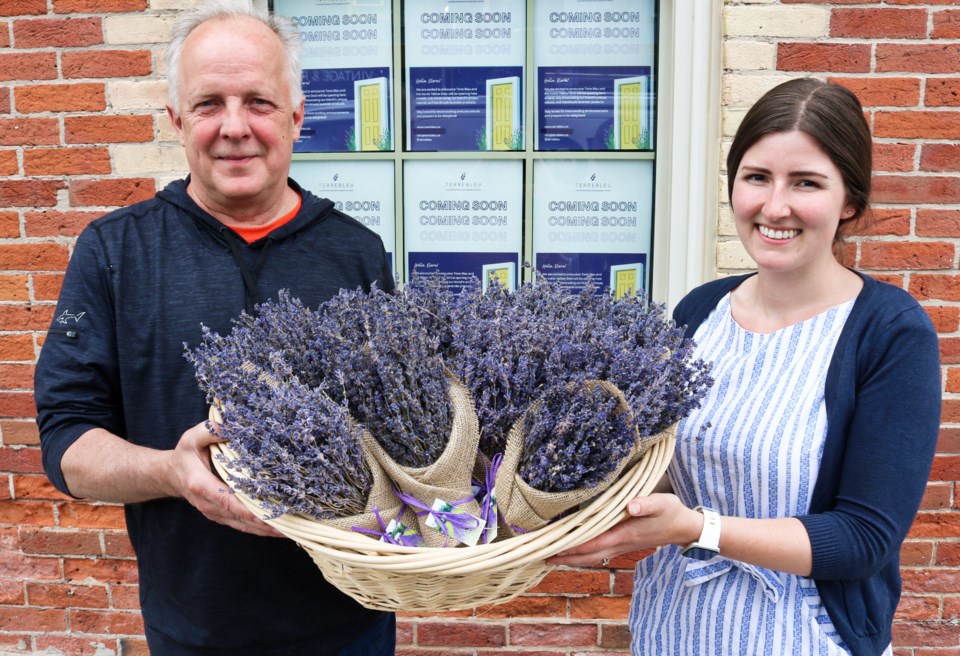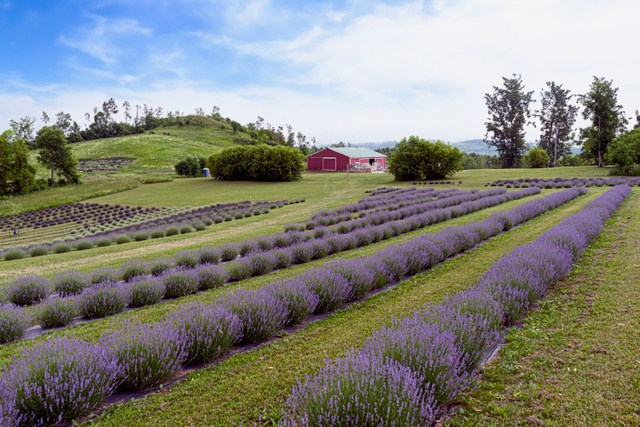EDITOR’S NOTE: This article originally appeared on The Trillium, a Village Media website devoted exclusively to covering provincial politics at Queen’s Park
Next year, Simcoe County goers could try a new experience — a visit to a lavender farm.
It’d be an occasion worth celebrating for Jim Muzyka, the farm’s owner, had he not already spent a half decade and six figures chasing it.
Muzyka’s been growing lavender at Fennario Meadows, his Creemore, Ont. farm, since 2019. Over the same period, he’s plodded through a cumbersome land-use approval process to get permission to offer a winery-esque experience at his farm.
Fennario Meadows’ future, for the time being, rests with the Ontario Land Tribunal (OLT). While its fate could be determined as soon as next spring, it likely won’t be until at least summer 2026 that residents and passersby alike will be able to pay to visit the farm.
Muzyka’s experience has led him to a belief shared by many whose business or property ambitions have been beleaguered by Ontario’s land-use approval system: that there must be a better way.
“It seems very nutty that this has gone as far as it has,” Muzyka said.
Muzyka had worked in tech for three decades by 2019. With his brother retiring, the pair purchased a 100-acre plot of previously farmed land in Creemore. Although Muzyka had long lived in the area, he and his brother’s earliest foray into farming had been through work they’d done while growing up in Saskatchewan.
Fennario Meadows, their farm, was supposed to be a challenge, according to Muzyka, just not because of the obstacles it’d eventually come to face.
“The real kind of question was: can we make a small farm a sustainable business?” Muzyka said.
The brothers considered starting a winery but opted against it in favour of growing lavender. “There are 100-acre wineries, but we thought wine was too far out of reach because the timeline to production in a winery is a lot longer,” Muzyka said. “So we looked at what’s parallel and that’s where we landed on lavender.”
Their idea was “to grow a crop that allows you to create value-added products downstream and successfully market them and, like a winery, have something like an on-farm tasting room experience,” Muzyka said.
It wasn’t guaranteed they’d be able to sustain a lavender-growing operation either. The plant is native to the Mediterranean coast. Little is grown in Ontario, much less that’s then sold. Could Fennario Meadows thwart fierce winter winds and threatening snowfalls to allow consistent harvests? The experimenting began in 2019, Muzyka said.

A few years later, Fennario Meadows purchased the brand of a more established Ontario lavender producer: Terre Bleu. It had belonged to the owner of a 200-acre lavender farm — among the largest, if not the biggest in Ontario — near Milton, which since 2014 had been a popular attraction for visitors.
The Milton farm closed in 2022 when its owner sold the property. Terre Bleu would live on through a new store in Elora, which Muzyka opened that summer.
Rather than as wine, Fennario Meadows’ harvest made it onto shelves in scents, personal care products like soaps, balms, and sprays, in flavoured snacks and drinks, and as part of bouquets and wreaths.

Unfortunately for Muzyka, his woes of winning approval to host visitors had escalated by then.
Fennario Meadows is on land that’s part of the Niagara Escarpment. The vast ridge spans from the Niagara River toward and past the Bruce Peninsula; the iconic almost 900-kilometre Bruce Trail gets its shape from the escarpment. Parts stretching from the Canada-U.S. border to Tobermory, in the northernmost area of what’s considered southwestern Ontario, have been under special provincial protections for decades.
To help preserve the lands, Ontario’s government approved the creation of the Niagara Escarpment Plan in 1985. Lands covered by the plan would be included in the Greenbelt, created later in 2005. The environmental protection plans are interconnected, with Niagara Escarpment’s policies applying to its lands within the Greenbelt, which make up roughly one-quarter of the latter’s total acreage.
Last updated in 2017, the Niagara Escarpment Plan’s stated purpose “is to provide for the maintenance of the Niagara Escarpment and land in its vicinity … and to ensure only such development occurs as is compatible with (the) natural environment.” Almost 500,000 acres of land are under its special protections. They vary in restrictiveness depending on the land’s characteristics and past use. It incorporates farmland and effectively untouchable scenic stretches — such as the Bruce Trail — but also incorporates some urban areas and mineral extraction zones, as examples.
Under the Niagara Escarpment Plan, wineries and similar agricultural-based businesses that host visitors can be allowed if they’re on what’s designated as prime agricultural land.
The plan is overseen by a commission of up to 17 provincially appointed board members and their team of just over two-dozen staff. To develop or make certain different uses of properties within it, landowners oftentimes must apply for permission from the Niagara Escarpment Commission.
Like many land-use decisions in the province, the commission can be appealed to the Ontario Land Tribunal for settling.
The quasi-judicial body’s current iteration is the product of years of tinkering by the Progressive Conservatives and Liberals before them. The Ford government has tried to speed up the tribunal’s decision-making, especially for housing projects. Despite majorly restructuring it, changing the laws shaping its operations multiple times, and steeply increasing its funding, the system’s backlog has continued to grow.
Muzyka applied to the Niagara Escarpment Commission in early 2021 for a permit for Fennario Meadows to host patrons, build a small shed to greet them and process lavender, and add parking on the property.
Unlike the properties where wineries and the like are most commonly opened, Fennario Meadows isn’t designated prime agricultural land.
Under the Niagara Escarpment Plan, most of the farm’s property is under the “Escarpment Protection Area” designation. These lands are important, the protection plan says, “because of their visual prominence and their environmental significance.” Farms are commonly allowed on Escarpment Protection Area lands. Single-dwelling homes, including with pools, can be built on them, as well as bed and breakfasts, and home industries — like trades’ shops.
Nevertheless, in October 2021, the Niagara Escarpment Commission conditionally approved Muzyka’s permit application, including for the shed and a 50-car lot. “The applicant proved through an independent agrologist that the land is prime agricultural land,” a report prepared by the commission’s staff said.
Muzyka had tried winning over his neighbours to support Fennario Meadows’ plan to welcome patrons to the property but was unsuccessful.
A group of them banded together to oppose it. Under the name “Preserve the Escarpment,” they created a website and purchased ads in the local newspaper and elsewhere warning of a lavender “theme park” that “could bring thousands of cars a week, disrupt our community and harm the sensitive environment of the escarpment.”
They also hired lawyers and appealed the commission’s approval to the OLT.

The Trillium reached Preserve The Escarpment through its Facebook page. In response to questions, the group described itself as “a group of farmers and seasonal and permanent community members who support responsible land-use along the escarpment and oppose attraction-type developments like Fennario Meadows.”
Preserve The Escarpment added that it believes Fennario Meadows, and likewise “attractions… don’t align with the principles of a protected ecosystem on prime agricultural land.”
Muzyka, meanwhile, said, “I think (Preserve The Escarpment’s) underlying fear is traffic.” He said Fennario Meadows’ intention to welcome visitors on a ticketed basis would help control the number of cars nearby at any given time, as would the planned 50-car lot’s capacity.
One nearby landowner involved with Preserve The Escarpment, and her counsel, have served as the group’s de-facto representatives in opposition to Fennario Meadows’ plans as it’s sought the approvals it's after. “Several of the group’s different members are lending their expertise and resources to the different aspects of our efforts,” the group wrote.
A typical case before the tribunal — like Muzyka’s was — is sort of like a court proceeding, albeit more casual. The government-appointed chair assigns a fellow appointee to adjudicate the case. Hearings follow that give each side a chance to argue why the land-use issue in question should or shouldn’t be allowed under Ontario’s laws.
There are benchmarks for how long it’s supposed to take for OLT cases’ first hearings to be scheduled and for how long it takes for an adjudicator to issue a decision, but they’re often missed.
While the OLT’s initial case management conference over the challenge to the commission’s approval for Fennario Meadows was held in February 2022, it wasn’t until almost a year later that the last of its hearings wrapped up.
In the meantime, the Niagara Escarpment Commission started working toward amending the plan it oversees. Its intention was to allow more farms like Muzyka’s on non-prime agricultural land-designated properties to operate on-farm diversified uses (ODFUs) — like visitor-friendly wineries and other value-added agri-businesses.
The Ontario Craft Wineries and Ontario Federation of Agriculture expressed their support for the amendment at a meeting by the commission in November 2022. Commission members then voted unanimously to move ahead toward making the change.
Muzyka’s opponents’ appeal of the commission’s approval for Fennario Meadows was heard over two weeks, starting in January 2023. The OLT adjudicator made their recommendation the next month. It wouldn’t be for almost another year, however, that Muzyka learned of the outcome after Natural Resources Minister Graydon Smith confirmed it, following the advice of the adjudicator.
The commission’s approval for Fennario Meadows was revoked on the grounds that it didn’t have the authority to declare the property as prime agricultural land.
A couple of months earlier, in November 2023, the Niagara Escarpment Commission voted to follow their staff’s advice and follow a pathway outlined in law by referring its amendment to broaden where ODFUs could operate to the OLT, initiating another tribunal proceeding. Preliminary hearings in the case were held in late February, late May, and at the end of July.
“We’ve got to take a different attitude towards how this works or there will be an impact, ultimately, to the economy around here,” Muzyka said.
Preserve The Escarpment’s position, meanwhile, is that allowing Fennario Meadows to open to visitors could burden the local community, which the group said doesn't have the infrastructure equipped to facilitate the business.
After the OLT’s hearing in July, the tribunal scheduled the case to play out over two weeks, starting about seven months later in March 2025. Muzyka pushed for an earlier hearing but was overruled to account for the availabilities expressed by the lawyers for both the commission and the owner of a property near Fennario Meadows who’s opposing the Niagara Escarpment Plan amendment.
“You’ve got to find a way to do some mediation around these topics that doesn’t have this big, sword of Damocles over it,” Muzyka said.
After the tribunal’s hearings about the commission’s amendment wraps up, an adjudicator will make a recommendation back to the commission. The commission will then make its own recommendation to the natural resources minister, who’ll have the final say over whether to amend the Niagara Escarpment Plan to allow ODFUs on broader land designations.
“As this matter is currently before the Ontario Land Tribunal for a hearing, the (natural resources) minister does not yet have a position on this amendment,” a ministry spokesperson wrote in an email to The Trillium.
The Ministry of Natural Resources spokesperson added, however, that the minister’s decision on any proposed amendments “would be based on the merits of the proposal” and “in the context of any relevant laws, policies, directives, standards and guidelines.”
By the dates the tribunal begins its hearings that could significantly shape Fennario Meadows’ fate, even more changes may be coming the OLT’s way.
Ontario’s auditor general is currently probing the land-use tribunal, as The Trillium reported earlier this month. A document the Ministry of Municipal Affairs and Housing prepared for the new associate housing minister in June said it expects the audit to be released before the end of this year.
The auditor general typically makes between several to dozens of recommendations for its audits’ subject organizations. The ministry responsible for the organization — a tribunal, in this case, which reports to the Ministry of the Attorney General — gets to decide which to act on. In most cases, ministries tend to work toward implementing at least some of the auditor’s recommendations within a couple of years.
In 2022, the Niagara Escarpment was the focus of an auditor general’s review. Former auditor general Bonnie Lysyk found the escarpment’s environmental protections had been weakened over time and that “almost all” development permit applications to the commission from 2017 to 2022 were approved (only 1.1 per cent were refused). She also found that Niagara Escarpment Plan amendments “can languish for years.”
The auditor general’s office is expected to release a follow-up report on the Niagara Escarpment and the progress the Ministry of Natural Resources has made in response to its recommendations by the end of this year.
Within a few years, the Niagara Escarpment Plan could also see its most significant write-through since 2017, or even beyond. Laws shaping it and the Greenbelt require them to undergo widely scoped reviews every 10 years.
In the aftermath of the Greenbelt scandal, the Ford government promised its next review would be led by conservation, agriculture, and environmental experts whose recommendations will be vetted by the province’s auditor general and environment commissioner.
The last Greenbelt and Niagara Escarpment Plan reviews began in 2015. A Ministry of Municipal Affairs and Housing document from June said the Greenbelt and Niagara Escarpment Plan reviews were expected to be launched this year. A spokesperson for the Natural Resources Ministry said in an email that the latest 10-year Niagara Escarpment review hadn’t started yet.
